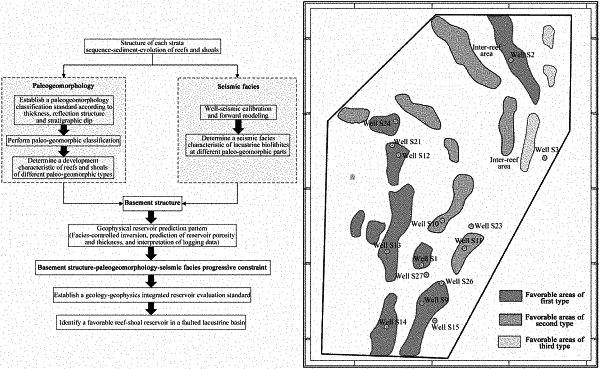| CPC G01V 1/30 (2013.01) [G01V 2210/60 (2013.01)] | 1 Claim |

|
1. A method for identifying a reef-bank reservoir in a faulted lacustrine basin based on a basement structure-paleogeomorphology-seismic facies progressive constraint, the method comprising:
(1) analyzing a basement structure of a work area to obtain a basement structure characteristic of the work area, expressed as follows:
G=Analyse(S);
wherein S is seismic data; Analyse(•) represents basement structure analysis on the seismic data; and G is a basement structure analysis result;
(2) establishing a paleogeomorphology classification standard according to thickness, reflection structure and stratigraphic dip to determine types of paleogeomorphology, so as to determine a development characteristic of different paleo-geomorphic reefs and banks, expressed as follows:
AI=Norm(H,R,D);
wherein H is the thickness; R is the reflection structure; D is the stratigraphic dip; Norm(•) is the paleogeomorphology classification standard; and AI is paleogeomorphology type;
(3) analyzing a seismic facies characteristic of lacustrine biolithites in different paleo-geomorphic parts through well-seismic fine calibration and forward modeling; and establishing a reef-bank identification method based on a paleogeomorphology-seismic facies constraint, expressed as follows:
M=F[AI,SF(ws,nm)];
wherein ws is a result of the well-seismic fine calibration; nm is the forward modeling; SF(•) is a seismic facies analysis; and F(•) represents method construction; and M represents the reef-bank identification method based on the paleogeomorphology-seismic facies constraint;
(4) combining with the basement structure analysis result, establishing a geology-geophysics integrated reservoir evaluation standard based on the basement structure-paleogeomorphology-seismic facies progressive constraint, expressed as follows:
Cn=B(G,M);
wherein B(•) indicates progressive constraining; Cn is the geology-geophysics integrated reservoir evaluation standard;
(5) identifying a favorable reef-bank reservoir in the faulted lacustrine basin based on the basement structure-paleogeomorphology-seismic facies progressive constraint; and
repeating steps (1) to (5) until data interpretations of the entire work area are processed, so as to obtain a prediction result of the favorable reef-bank reservoir in the faulted lacustrine basin of the work area; and
(6) locating different types of favorable areas based on the prediction result of the favorable reef-bank reservoir, and drilling wells in the work area according to the different types of favorable areas.
|